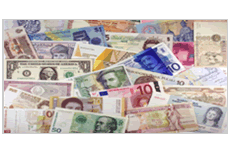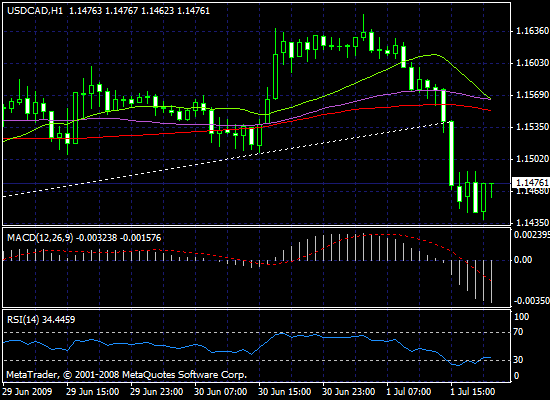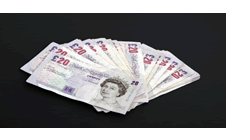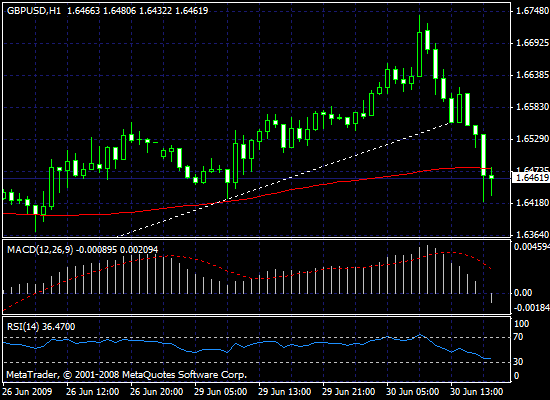Source: ForexYard
The surprise drop in consumer confidence in the United States yesterday has resulted in a sudden buy-up in USD as investors flock to safe-havens. With a market that appears to be lacking a clear direction recently, major reports such as the CB Consumer Confidence report yesterday, and today’s ADP Non-Farm Employment Change report become that much more important to watch as more investors await their release before trading.
Economic News
USD – USD Trades Higher on Economic Outlook
The greenback gained Tuesday as a report on U.S. home prices showed that the pace of price declines may be slowing and manufacturing data from June came in slightly better than expected. The Dollar may extend its gains versus the EUR after a report showed an unexpected drop in U.S. consumer confidence for June, increasing demand for the safety of the world’s main reserve currency.
The USD traded at 1.4035 versus the EUR, following a 0.4% gain yesterday. The dollar also fetched 96.35 yen following a 0.3% advance. Tuesday’s data gave investors more reasons to buy the U.S Dollar. For months, improvements in the outlook for the economy, financial markets or other companies has led to stock gains and weighed on the USD, taken as a signal of reduced demand among investors to hold the safe-haven currency.
However, analysts have said that the Dollar may be near a turning point, after trading in a pattern closely correlated with equity moves. Investors have sold U.S. Dollars recently as stock markets and oil prices rose on an upbeat view for prospects of a global economic recovery, hurting demand for the greenback as a safe haven.
Investors now await the U.S. government’s high-profile monthly employment report. The jobs data is due on Thursday as U.S. financial markets will be shut on Friday for Independence Day.
EUR – EUR Holds Steady vs. Greenback and Rallies against JPY
The EUR gained versus the U.S Dollar on speculation European Central Bank (ECB) policy-makers will today signal that the central bank will keep Interest Rates on hold into next year to aid an economic recovery. ECB member Axel Weber said last week that the central bank has used up its scope to cut Rates. Policy-makers will leave the benchmark rate unchanged at this week’s meeting, according to analyst predictions.
There is also an improving sentiment in the Euro-Zone’s economic conditions. European economic confidence rose more than economists forecast in June, the European Commission in Brussels reported yesterday, signaling the region’s slump is abating. Analysts predict that the ECB will keep Rates at 1% for the foreseeable future. And that might turn the EUR further on the upside.
The European currency has advanced the most in 4 months against the Yen, last traded at 135.56 yen from 135.21 yesterday. When it reached 135.96 for a brief stint yesterday, this was the highest level reached since June 15. The EUR has risen 7.1% versus the Japanese yen this year and doesn’t seem to be losing any momentum.
JPY – Yen Declines as Investors Dump Safety Demand
The Japanese Yen weakened against the EUR and the Dollar yesterday after a report showed China’s manufacturing expanded for a 4th consecutive month, dampening demand for the relative safety of Japan’s currency. The JPY fell to 135.80 per EUR and weakened to 96.95 per U.S. Dollar from 96.36. The Yen also fell against 15 of the 16 most-traded currencies after an Australian report showed retail sales climbed for a 3rd month, giving investors more confidence to purchase higher-yielding assets.
Although, the Bank of Japan’s (BOJ) June Tankan corporate survey showed on Tuesday that big manufacturers’ sentiment pulled back from a record low hit 3 months ago, the improvement was smaller than forecast. The Yen edged down against the Dollar after the news but the market’s reaction was subdued overall as investors decided that it offered no surprise.
Analysts said that the market has considered all the positive factors that have come out and is starting to react more to negative factors. The market is lacking clear direction and is likely to stay in an adjustment period for now.
Crude Oil – Crude Oil Momentum to Rise Further
Crude Oil rose above $70 a barrel after an industry report showed the biggest decline in crude inventories since September in the U.S., the world’s largest user of the fuel. Also today, the Energy Information Administration (EIA) report will probably give a better direction to the market.
A U.S. Energy Department report today will likely show Crude Oil stockpiles declined 2 million barrels, according to economists’ estimations. A fall in crude inventories may cause the commodities market to move higher, and will reinforce Crude to stay at or go above current levels.
Oil prices yesterday spiked above $73 a barrel, which stood as the June high for more than 2 weeks, as the Dollar declined and escalating militant attacks in Nigeria raised concern that supplies may be disrupted. Crude Oil is set to extend gains amid this week’s volatility and may reach the $76 a barrel level.
Technical News
EUR/USD
This pair currently lacks clear direction. With most indicators either floating in neutral territory, or giving off mixed signals, this pair continues to trade in a distinct range. Buying on lows and selling on highs within this range is the most preferable strategy in this environment.
GBP/USD
There is a distinct bullish cross on the 4-hour chart’s Slow Stochastic and an imminent bullish cross on the hourly chart’s MACD. These two signals together indicate an impending bullish correction to yesterday’s sharp downward movement. Going long might be wise today.
USD/JPY
Yesterday’s volatile bullish movement in this pair has pushed the RSI on the hourly and 4-hour charts into the over-bought territory, representing the presence of downward pressure. The fresh bearish cross on the 4-hour chart’s Slow Stochastic supports the notion of a downward correction. Going short with tight stops appears to be preferable.
USD/CHF
Almost all indicators on this pair show neutrality as the price floats near the 1.0850 price level. With a bearish cross on the hourly MACD and a bullish cross on the 4-hour MACD, the direction of this pair is uncertain. Waiting for a clearer signal might be a good choice today.
The Wild Card – EUR/GBP
The price of this pair has been trading flat these past several days. However, the Bollinger Bands on the hourly and daily charts are tightening, signaling an impending volatile jump. With a bearish cross on the hourly MACD and the 4-hour chart’s Slow Stochastic, this volatile jump may very well be bearish. Forex traders have a great opportunity to enter early sell positions before this jump takes place and ride out the downward slope for profits!
Forex Market Analysis provided by Forex Yard.
© 2006 by FxYard Ltd
Disclaimer: Trading Foreign Exchange carries a high level of risk and may not be suitable for all investors. There is a possibility that you could sustain a loss of all of your investment and therefore you should not invest money that you cannot afford to lose. You should be aware of all the risks associated with Foreign Exchange trading.
 This was the eighteenth straight month that companies have shed workers and the unemployment rate jumped from 9.4 percent to 9.5 percent bringing the rate to its highest standing since 1983.
This was the eighteenth straight month that companies have shed workers and the unemployment rate jumped from 9.4 percent to 9.5 percent bringing the rate to its highest standing since 1983.






